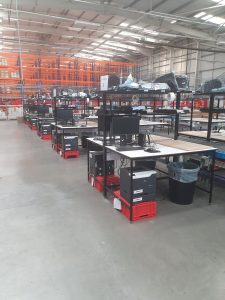Your basket is currently empty!

It is essential to determine the amount of warehouse space available accurately. If you underestimate, there may not be enough room for inventory. If you overestimate, you may have more storage capacity than needed. Calculating warehouse capacity is a complex process involving several steps.
Calculate total square footage
Firstly, measure the total square footage, the overall area of the warehouse.
Identify usable storage space
Identify and measure non-storage areas including offices, packing areas, toilets, aisles and loading areas. Calculate the usable space by subtracting the total non-storage space from the total square footage of the warehouse.
Determine clear height
Determine the maximum height that items can be stacked. This will not be the full ceiling height, as there are safety regulations that prevent items from being stacked too high, touching light fittings or heating ducts.
Calculate storage capacity
To calculate the gross storage capacity in cubic feet, multiply the maximum stack height by the usable storage area.
Consider other factors
The usable storage capacity will be less than the gross storage capacity calculated in the above step. The racking and shelving systems take up space. Your warehouse equipment supplier can provide accurate storage equipment measurement data. Pallet dimensions reduce the usable storage space.
The type of inventory affects storage space requirements. Some items cannot be stacked on top of each other, especially if they are fragile, heavy or have an irregular shape. This can mean that there is unused storage space above items.
Smaller quantities of items with short expiry dates or in low demand may be stocked, resulting in lower stack heights.
By following these steps, the storage capacity of the warehouse can be calculated. It may not be exact, but it is accurate enough to inform decisions about utilising space and planning the future of the warehouse.
If the total storage capacity is less than needed for current and future operations, there are ways to increase it. New racking and shelving systems may optimise storage space better. Narrowing aisles can free up storage space as long as there remains sufficient space to comfortably work in. A mezzanine floor increases storage space.
You may also interested in:

Four tips to prepare your warehouse for peak season
Peak season has rolled around again, and it’s nearly time to up the pace. Your warehouse will soon be subject to
How to avoid manual handling accidents with vans
Warehouses where items are loaded into vans can pose a risk of
